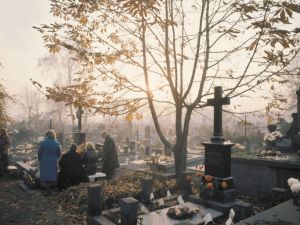 The casket industry in the United States is said to be a 1.5 billion dollar industry, with a typical price tag for a steel coffin coming in at around $2,500. In past decades and until fairly recently, up to 90% of burials in the U.S. involved a coffin that was made in the USA by one of three major manufacturers. While similar caskets may be had from China or over the internet for considerably less money, most people tend not to shop around. They often simply purchase what they need at the recommendation of the funeral director. With changes in church policy and concerns about the environmental impact of traditional burials, an industry that was once highly insular is starting to open up to some different possibilities.
The casket industry in the United States is said to be a 1.5 billion dollar industry, with a typical price tag for a steel coffin coming in at around $2,500. In past decades and until fairly recently, up to 90% of burials in the U.S. involved a coffin that was made in the USA by one of three major manufacturers. While similar caskets may be had from China or over the internet for considerably less money, most people tend not to shop around. They often simply purchase what they need at the recommendation of the funeral director. With changes in church policy and concerns about the environmental impact of traditional burials, an industry that was once highly insular is starting to open up to some different possibilities.
The High Price of Dying
In the late 19th century and throughout the 20th, funerals became indoor events. They began to take on what most people picture as the typical funeral profile, with an embalmed body available for viewing by family and friends followed by a funeral service and burial. Caskets evolved past the shroud and the pine box to elaborate constructions often lined in fine fabric. As a general rule, funeral directors took over the responsibilities of organizing the funeral services and events from the family. Today this sort of service has become prohibitively expensive for many, particularly due to what is perceived by some to be a virtual monopoly on the casket industry. Many people have opted for cremation as a more financially viable alternative.
Environmental Issues With Both Burial and Cremation
Traditional burials present a number of environmental challenges. The use of formaldehyde in embalming may leach into the soil. Metal constructions for coffins may be slow to break down, and space itself may be at a premium in many locations. Although many see it as a more earth-friendly option, cremation has its issues as well. The process may release a significant amount of greenhouse gases into the atmosphere. For people who are looking for greener ways to be buried, some old-fashioned approaches may be making a comeback. Caskets options may include:
- Cardboard
- Wicker
- Paper mache
A Return to the Earth
One of the driving ideas behind greener burials is a connection to the land itself. Bodies are interred without any embalming. Coffins may be biodegradable. People may even choose to be buried in a shroud made of natural fibers or from a material made from mushrooms. There are natural burial sites where the idea is to blend into the landscape without large headstones or markers. Natural sites may be more popular at this point in European countries where available land may be more of an issue than in the United States. In addition to Great Britain, Finland, Holland and Germany are countries where the number of people who are choosing greener burials is growing.
A Shift in Attitude
There have been reports in the past few years of members of British society and other notables requesting to be buried in a cardboard casket. While to some it may just seem like an eccentric gesture, for others it may indicate a shift in the way western cultures perceive dying and the funeral experience. There are people for whom it no longer makes sense to be buried in an expensive metal box just for the sake of ceremony and transport of their body to a burial site. Whereas an elaborate casket may have indicated wealth or honor throughout the last century, it may not be the practical or logical option for many people today. As with most end-of-life issues, the most important part may be for people to let loved ones know their wishes. A little planning and conversation may help family avoid last minute and costly decisions.
Add Your Comment